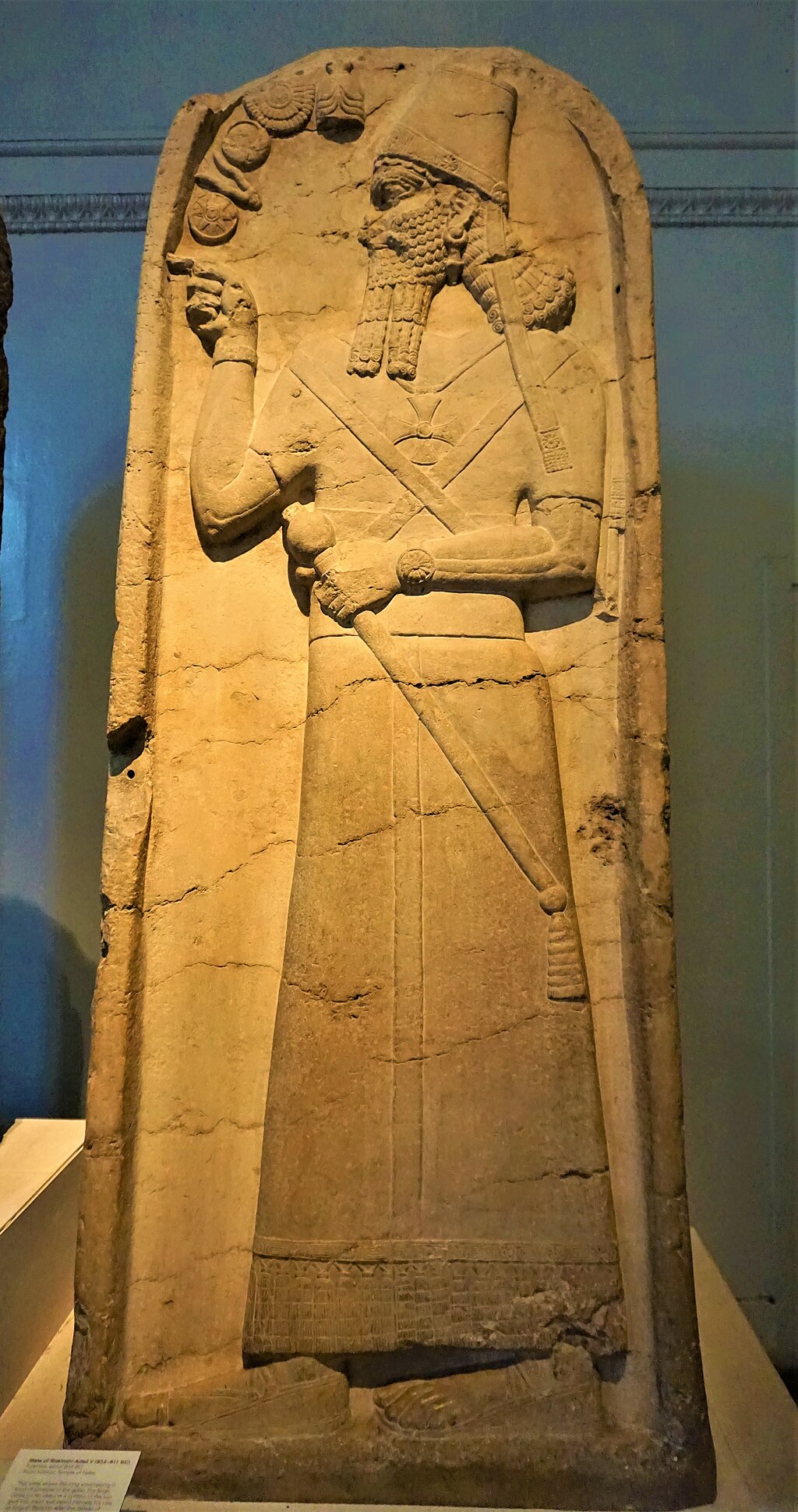
The Stela of Shamshi-Adad V is a massive round-topped white limestone monolith that portrays the Assyrian King worshipping his gods.
The monarch is shown wearing a conical hat, and full beard with his right hand extended snapping his fingers and his left hand holding a mace, his symbol of royal authority.
A significant amount of cuneiform text covers the sides of the stela, recording the king’s military campaigns.
The king stands in the gesture of blessing before five divine emblems representing five deities, which are represented symbolically in the top left-hand corner of the stela.
The five symbols are the horned helmet, the winged disk, the crescent, the forked line, and the eight-pointed star. The cross worn as an amulet by the king is a symbol of the sun god.
Shamshi-Adad V was named after a god and was the King of Assyria from 824 to 811 BC. The early years of his reign saw a severe struggle for his succession.
The revolt was led by his rebellious brother, who succeeded in bringing to his side 27 principal cities, including Nineveh.
The rebellion lasted for six years and weakening the Assyrian empire, and its ruler and this weakness continued to reverberate in the kingdom until the reforms of future kings.
Assyria
The Assyrian Empire was a major Mesopotamian empire of the ancient Near East and the Levant named after its original capital, the ancient city of Aššur.
It existed as a state from the 25th century BC until its collapse in the early 600’s BC. Several Neo-Assyrian states arose latter at different times.
At its peak, the Assyrian empire stretched from Cyprus and the East Mediterranean to Iran, and from what is now Armenia and Azerbaijan in the Caucasus, to the Arabian Peninsula, Egypt and eastern Libya.
Assyrians
The ancient Assyrians followed the ancient Mesopotamian religions, with their national god Ashur having the most prominent role during the Assyrian Empire.
The ancient Assyrian religion gradually declined with the advent of Syriac Christianity between the first and tenth centuries.
The indigenous modern Eastern Assyrian Christian ethnic minority in northern Iraq, northeast Syria, southeast Turkey, and northwest Iran are the descendants of the ancient Assyrians.
According to the Biblical generations of Noah, the city of Aššur was founded by a biblical Ashur, the son of Shem. Later generations worshiped him as the city’s patron god. The ancient city of Aššur is located in modern-day Iraq.
Stela of Shamshi-Adad V
- Title: Stela of Shamshi-Adad V
- Date: 815 BC -811 BC
- Findspot: Temple of Nabu, Nimrud (Kalhu), North Iraq – 1855
- Materials: White limestone
- Culture: Neo-Assyrian
- Dimensions: H: 195.24 cm W: 92.54 cm; D: 71.96 cm
- Museum: The British Museum
Shamshi-Adad – Assyrian
Tour the Middle East Collection at the British Museum
- The Lion Hunt
- Cyrus Cylinder
- Royal Game of Ur
- Gilgamesh Flood Tablet
- Stela of Shamshi-Adad V
- Standard of Ur
- Ram in a Thicket
- Tell al-‘Ubaid Copper Lintel
- Assyrian Sacred Tree – Wall Panel Relief
- Babylonian Map of the World Tablet
The rise and fall of the Assyrian Empire
Tour of Mesopotamian Art
- Gudea, Prince of Lagash
- Sumerian Standing Male Worshiper
- Human-Headed Winged Bull
- Gilgamesh Flood Tablet
- Ishtar Gate
- Cuneiform Tablet
- Cyrus Cylinder
- Lion Hunting Scene – 750 BC
- Lion Hunt Relief from Nimrud
- Temple of Ashur Water Basin
- Victory Stele of Esarhaddon
- The Lion Hunt
- Cyrus Cylinder
- Royal Game of Ur
- Gilgamesh Flood Tablet
- Stela of Shamshi-Adad V
- Sumerian Standing Male Worshiper
- Head of a Beardless Royal Attendant – Eunuch
- Human-Headed Winged Bull (Lamassu)
- Law Code of Hammurabi
- Gudea, Prince of Lagash
- Victory Stele of Naram-Sin
- Statue of Ebih-Il
- Standard of Ur
- Mesopotamian Art
Ancient Assyria
~~~
“There is no shame in not knowing the shame lies in not finding out.”
– Assyrian Proverb
~~~
Photo Credit: 1) JOM
Popular this Week








 Sponsor your Favorite Page
Sponsor your Favorite Page SEARCH Search for: Search Follow UsJoin – The JOM Membership Program
Sponsor a Masterpiece with YOUR NAME CHOICE for $5
Share this:
- Tweet
